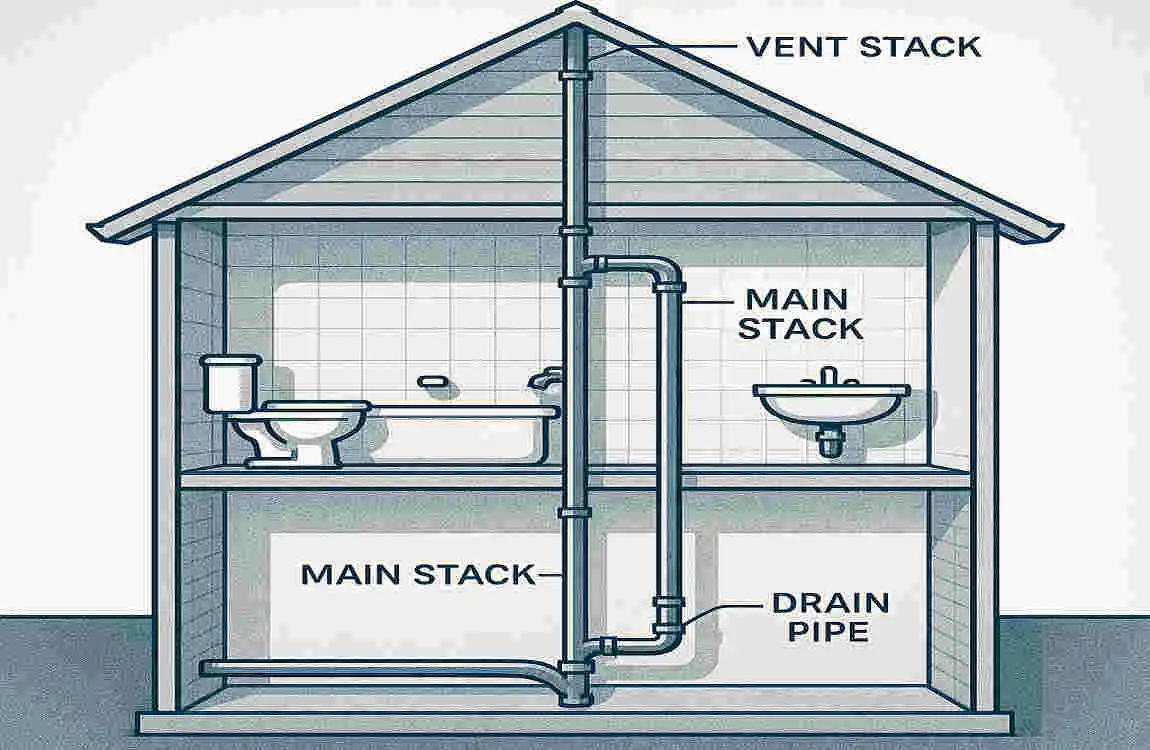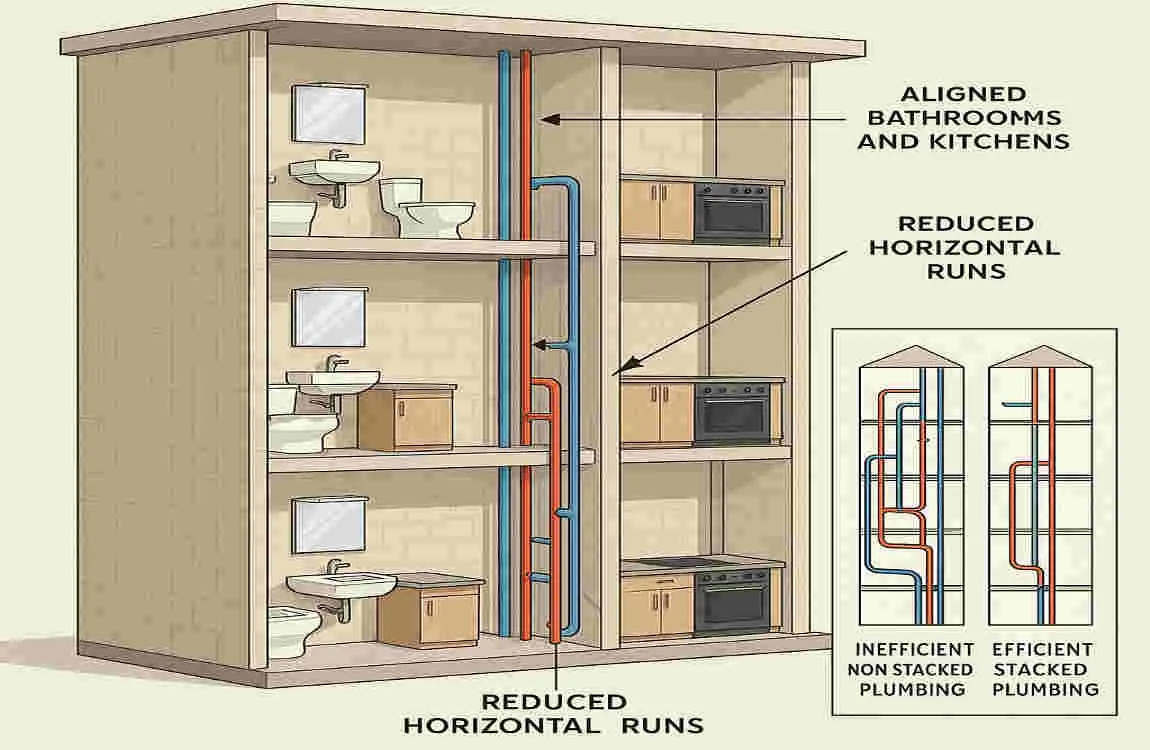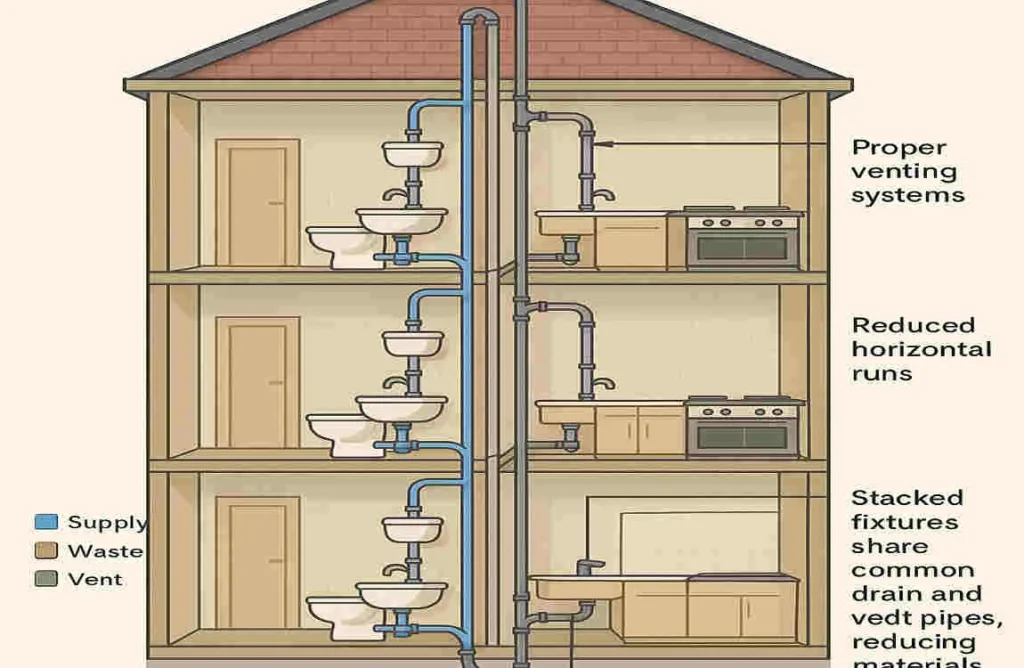Have you ever wondered what keeps your home’s plumbing running smoothly without nasty backups or weird smells? If you’re a homeowner, understanding the stack in-house plumbing is key. This vital part of your house plumbing system acts like the backbone, ensuring everything flows as it should.
In-house plumbing systems are more than just pipes hidden behind walls. They handle everything from flushing toilets to running sinks, keeping your daily life comfortable. At the heart of it all is the plumbing stack, often called a vent stack. This isn’t some fancy gadget; it’s a straightforward vertical pipe that plays a massive role in preventing problems. By grasping the concept of the stack in-house plumbing, you can spot issues early and save yourself from costly repairs. Let’s explore why this unsung hero matters so much.
What Is a Stack in House Plumbing?

Imagine your home’s plumbing as a busy highway system. The stack in-house plumbing is like the central expressway that keeps traffic moving without jams. But what exactly is it? Let’s break it down.
Definition of a Plumbing Stack
A plumbing stack, also known as a vent stack or plumbing vent, is essentially a vertical pipe that runs from your home’s drains up through the roof. It connects all the smaller pipes from your sinks, toilets, and showers. Think of it as the central pillar in your house plumbing system that handles both waste removal and air flow.
This stack isn’t just any pipe—it’s designed to be tall and straight, often extending above the roofline. Why? Because it needs to vent out gases safely while allowing wastewater to drain down efficiently. Without it, your plumbing would be a mess of clogs and odors.
Components of a Plumbing Stack
Let’s look at the key parts that make up this system. The central stack pipe is the big vertical tube, usually made of durable materials like PVC or cast iron. It connects to smaller branch drains from your fixtures.
Then there’s the roof vent, which pokes out of your rooftop. This opening allows air to enter and gases to exit, preventing pressure issues. Don’t forget the traps—those U-shaped bends under sinks that hold water to block sewer smells. All these pieces work together seamlessly.
How the Stack Integrates with Other Plumbing Parts
The stack doesn’t work alone. It ties into your entire house plumbing system, linking drains from multiple floors. For example, in a two-story home, the stack runs from the basement up to the attic, collecting waste along the way.
Visualize it: wastewater from your upstairs bathroom flows into branch pipes, then merges into the stack for a quick drop to the sewer line. Air enters through the vent to keep things balanced. This integration ensures smooth operation, even when multiple people use the plumbing at once.
Visualizing the Plumbing Stack
Picture a tall straw standing upright in your home. Smaller straws feed into it from sinks and toilets. Water flows down, air flows up—simple, right? This central vertical pipe is what makes the in-house plumbing stack so effective. If you’ve ever seen a pipe sticking out of a roof, that’s likely your vent stack at work.
The Primary Functions of a Plumbing Stack
Now that you know what a plumbing stack is, let’s talk about what it actually does. These functions are crucial for a healthy house plumbing system. We’ll explain each one clearly so you can see why it’s indispensable.
You may also read (how to identify 1990s house plumbing types).
Wastewater and Sewage Removal
First up, the stack excels at removing dirty water and waste. Its vertical design uses gravity to pull everything downward quickly. Unlike horizontal pipes that can slow down flow, the stack keeps things moving fast.
This means less chance of buildup in your pipes. When you flush or drain the sink, the stack ensures waste heads straight to the main sewer without lingering.
Venting Sewer Gases Safely
Nobody wants smelly sewer gases in their home. The plumbing stack vents these gases right out through the roof, away from your living spaces. It’s like an exhaust fan for your pipes.
By directing odors upward and outward, it keeps your indoor air fresh. This is especially important in bathrooms and kitchens where gases can build up.
Regulating Air Pressure
Air pressure might sound technical, but it’s straightforward. The stack lets air into the pipes to balance pressure, ensuring water flows smoothly without gurgling or backups.
Think about it: when water rushes down, it creates a vacuum. The vent stack fills that vacuum with air, preventing slowdowns. This keeps your drains working like they should.
Preventing Negative Pressure Buildup
Negative pressure can suck the water out of traps, letting gases in. The stack prevents this by maintaining even pressure. No more weird noises or slow drains—just reliable performance.
Maintaining Hygiene
Finally, by keeping gases out and traps sealed, the stack protects your health. It stops harmful bacteria and odors from entering your home, creating a safer environment for you and your family.
- Quick drainage: Handles multiple fixtures at once.
- Odor control: Vents gases high above the roof.
- Pressure balance: Ensures no backups or slow flows.
How Stacking Improves In-House Plumbing Systems

So, how does all this stacking magic make your plumbing better? Let’s dive into the benefits. You’ll see why a well-designed in-house plumbing stack is a game-changer for homeowners like you.
Efficiency of Vertical Stacks
Vertical stacks beat horizontal drains hands down for efficiency. Gravity does the heavy lifting, speeding up wastewater removal. This means fewer clogs and faster drainage, even in busy households.
Imagine running the dishwasher while someone showers—without a stack, things could back up. But with one, everything flows effortlessly.
Improved Drainage Capacity
During peak times, like morning routines, your plumbing gets a workout. The stack handles the load by providing a direct path for waste. This boosts overall capacity, preventing overflows.
It’s like having an extra lane on a highway during rush hour. Your house plumbing system stays reliable no matter what.
Prevention of Sewage Backup
Nobody wants a flooded bathroom. Stacking prevents backups by ensuring a smooth flow and proper venting. It stops sewage from reversing into your home, saving you from messy cleanups.
Elimination of Unpleasant Odors
By venting gases outside, the stack keeps your home smelling fresh. No more dealing with sewer smells that make guests wrinkle their noses. It’s a simple way to maintain a pleasant living space.
Contribution to Water Trap Seals
Traps under sinks hold water to block gases. The stack’s pressure regulation keeps these seals intact. This double layer of protection enhances hygiene and prevents health issues.
Supporting System Durability
Overall, stacking makes your plumbing last longer. It reduces wear and tear on pipes, leading to fewer repairs. Investing in a good stack of in-house plumbing pays off in durability and peace of mind.
Common Problems with Plumbing Stacks and Their Impact on Plumbing Systems
Even the best systems can have issues. Let’s talk about what can go wrong with your plumbing stack and how it affects your home. Recognizing these early can save you headaches.
Clogging and Blockages
Clogs are a top problem. Leaves, bird nests, or debris can block the vent stack, causing drainage to slow. Wastewater can’t flow properly, leading to backups.
Effects of Vent Stack Failure
If the stack fails, you might notice sewage odors sneaking in. Slow drains become common, and in worst cases, health risks from gases arise. It’s not just annoying—it’s hazardous.
Improper Installation or Damage
Bad setup or cracks from age can mess with air pressure. This leads to unbalanced systems, where water doesn’t drain properly. Over time, it can damage other pipes too.
Signs and Symptoms to Watch For
Keep an eye out for gurgling sounds, slow drains, or foul smells. Wet spots near pipes could signal issues. If you spot these, don’t ignore them—act fast.
Here’s a quick table to help you identify problems:
Problem Symptoms Potential Impact
Clogging , Slow drains, gurgling , Backups, flooding
Gas Leakage Foul odors Health risks, discomfort
Pressure Imbalance Noisy pipes, backups System inefficiency, damage
Physical Damage : Visible cracks , Leaks, and costly repairs
Proper Installation and Maintenance of Plumbing Stacks
Installing and maintaining your in-house plumbing stack isn’t rocket science, but it requires care. Let’s walk through how to do it right.
Planning and Positioning
Follow local building codes for placement. The stack should run straight up, avoiding bends that could cause issues. Position it centrally for best integration with drains.
Materials Used
Common materials include PVC for its durability and ease, or cast iron for older homes. Roof vents are often capped to prevent debris entry while allowing air flow.
Maintenance Tips
You may also read (a guide to selecting glue for home hot tub repairs).
Regularly inspect for blockages—clear them with a plumbing snake if needed. Schedule professional checks yearly. Simple steps like avoiding flushing non-flushables help too.
When to Consider Replacement
If your stack is old or damaged beyond repair, replace it. Signs include persistent clogs or leaks. A pro can assess and upgrade to modern materials.
Importance of Regular Maintenance
Staying on top of maintenance ensures long-term performance. It prevents minor issues from becoming big problems, keeping your house’s plumbing system efficient.
Advantages of Stacking in Modern Plumbing Design
In today’s homes, stacking isn’t just functional—it’s innovative design. Let’s explore how it fits into modern setups.
Compliance with Regulations
Modern stacks meet strict plumbing codes, ensuring safety and efficiency. This compliance protects your home and avoids legal hassles.
Enhanced Water Conservation
Efficient drainage means less water waste. Stacks help systems use water wisely, supporting eco-friendly living.
Reduced Risk of Failures
With proper stacking, failures drop dramatically. This cuts repair costs and extends the life of your plumbing.
Improved Home Environment
Enjoy an odor-free, hygienic space. Stacking keeps things safe and comfortable for your family.
Supporting Advanced Technologies
Stacks integrate with smart plumbing tech, like sensors for leak detection. This makes your system future-proof.
- Cost savings: Fewer repairs over time.
- Eco-benefits: Better water use.
- Tech integration: Ready for innovations.
How to Identify If Your Home’s Plumbing Stack Is Functioning Properly
Wondering if your stack is up to par? Here’s how to check. You don’t need to be an expert—just observant.
Practical Checks for Ventilation
Flush a toilet and listen—no gurgling means good venting. Run multiple fixtures; if drains stay fast, your stack is fine.
Visible Signs of Failing Stacks
Look for odors, backups, or unusual noises. Roof vent issues, like bird nests, are telltale signs.
When to Consult a Professional
If DIY checks raise red flags, call a plumber. They can inspect thoroughly and fix issues before they worsen.
You may also read (how to choose a pressure boost shower head for your home).

